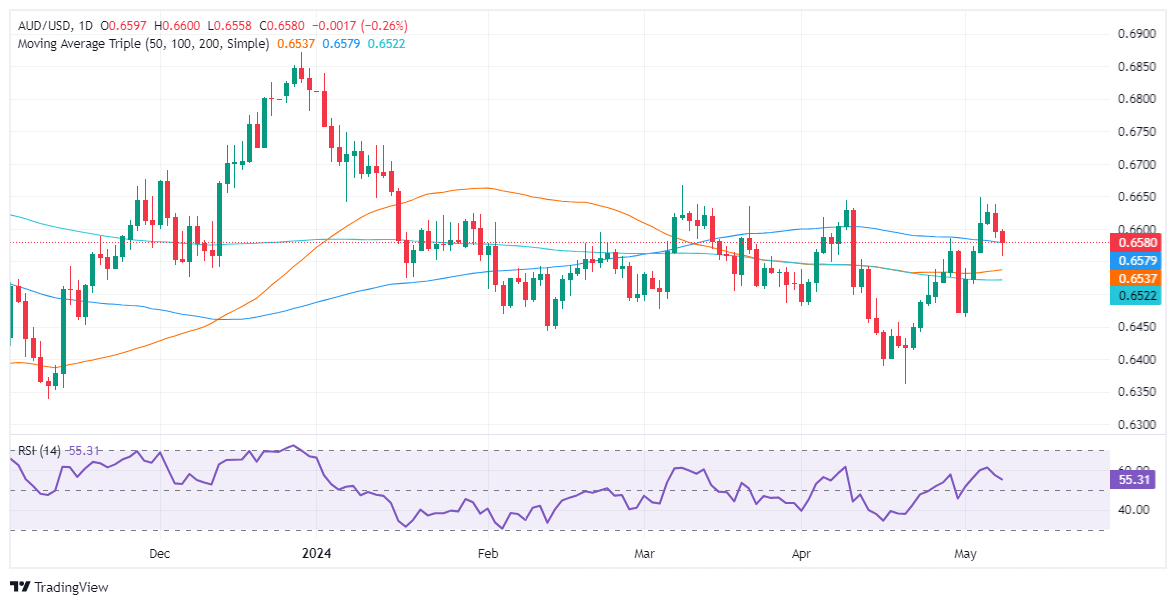- Analytics
- News and Tools
- Market News
- AUD/USD weakens further as US Treasury yields boost US Dollar
AUD/USD weakens further as US Treasury yields boost US Dollar
- AUD/USD drops 0.26%, pressured by higher US Treasury yields and risk aversion, contributing to a 0.70% two-day decline.
- RBA keeps rates steady; nuanced inflation comments lead to negative market reaction for AUD/USD.
- US Fed caution echoed by Boston Fed President Susan Collins, warning against premature rate cuts amid September cut expectations.
The Australian Dollar extended its losses against the US Dollar for the second straight day, as higher US Treasury bond yields underpinned the Greenback. On Wednesday, the AUD/USD lost 0.26% as market participants turned risk-averse ahead of the release of further US data during the rest of the week, followed by next week’s inflation report. As the Asian session begins, the pair trades at 0.6577, virtually unchanged.
AUD/USD dips amid rising US yields and cautious market sentiment ahead of key economic data releases.
The financial markets remain strictly focused on when the major central banks would ease policy. on Tuesday, the Reserve Bank of Australia (RBA) decided to keep rates unchanged, though slightly tweaked their statement, mentioning that inflation is indeed cooling. Despite adding that “the Board is not ruling anything in or out,” AUD/USD traders punished the Aussie Dollar, as it has lost close to 0.70% in the last two days.
RBA’s Governor Michele Bullock maintained a balanced tone at the press conference. Regarding rates, she mentioned that "we might have to raise, we might not," indicating the board's contemplation of rate hikes at this meeting.
On the US front, Federal Reserve officials continued to cross the newswires. Boston Fed President Susan Collins stated that she expects demand to slow down to bring inflation to the Fed’s 2% goal. She added that there are risks of cutting rates “too soon” and mentioned that the current policy is well-positioned and that it is “moderately restrictive.”
Regarding interest rate expectations, the swaps market has largely discounted any further RBA rate hikes over the next six months, with a decrease priced in for the subsequent six months.
On the US front. the CME FedWatch Tool shows that odds for a quarter-percentage-point cut in September by the Fed increased from 55% last week to 85% as of writing.
AUD/USD Price Analysis: Technical outlook
From a daily chart perspective, the pair is neutral to upward biased, though buyers need to surpass the latest cycle high seen at 0.6667 the March 8 high, which could exacerbate a rally toward 0.6700. Once cleared, the next resistance level would be the December 28 high at 0.6871. On the other hand, if sellers push prices below the 100-day moving average (DMA) at 0.6577, subsequent losses are awaited. The next demand level would be the 50-DMA at 0.6535, followed by the 200-DMA at 0.6515.
© 2000-2024. All rights reserved.
This site is managed by Teletrade D.J. LLC 2351 LLC 2022 (Euro House, Richmond Hill Road, Kingstown, VC0100, St. Vincent and the Grenadines).
The information on this website is for informational purposes only and does not constitute any investment advice.
The company does not serve or provide services to customers who are residents of the US, Canada, Iran, The Democratic People's Republic of Korea, Yemen and FATF blacklisted countries.
Making transactions on financial markets with marginal financial instruments opens up wide possibilities and allows investors who are willing to take risks to earn high profits, carrying a potentially high risk of losses at the same time. Therefore you should responsibly approach the issue of choosing the appropriate investment strategy, taking the available resources into account, before starting trading.
Use of the information: full or partial use of materials from this website must always be referenced to TeleTrade as the source of information. Use of the materials on the Internet must be accompanied by a hyperlink to teletrade.org. Automatic import of materials and information from this website is prohibited.
Please contact our PR department if you have any questions or need assistance at pr@teletrade.global.
















